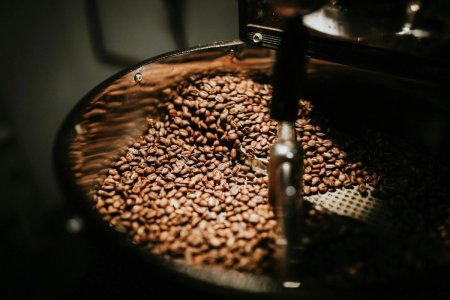Why this morning essential could soon cost more—and it’s not just inflation
By
Veronica E.
- Replies 0
You might want to brace yourself the next time you reach for your morning brew.
That familiar comfort in your cup could soon come with a higher price tag—and it’s not just about inflation or the weather.
A recent development might make your daily cup of coffee noticeably more expensive, and many Americans are already starting to feel the pinch.
Coffee has long been a staple in American households, with its inviting aroma and energizing effects starting countless mornings across the country.
But lately, the path from bean to mug has been getting more expensive—and not just because of market shifts or growing conditions.

This time, it’s something less expected: tariffs.
These newly imposed taxes on imports are causing a stir in the coffee world, and the cost increases are beginning to affect customers directly.
What tariffs have to do with your cup of joe
Dozens of coffee-exporting countries are now facing increased tariffs under new US trade rules.
Coffee shops and roasters are being hit hard—and many of them are now facing tough choices when it comes to their pricing.
Even before these tariff hikes were introduced, prices had already been rising.
Poor weather in major coffee-producing countries like Brazil and Vietnam has led to lower yields, which pushed up prices at grocery stores.
According to government data, the average price of ground coffee reached $7.38 a pound in March—up 84% since January 2020.
Also read: Discover 7 groceries immune to tariffs: How to outsmart rising prices at the store
Now with a 10% global tariff on all US coffee imports—and even higher for countries like India and Vietnam—experts are warning that the impact on consumers could grow even sharper.
The US imports about 99% of its coffee, with just 1% grown in places like Hawaii and Puerto Rico.
Considering Americans spend close to $110 billion a year on coffee, it’s easy to see how a small shift in import costs could cause a ripple effect nationwide.

Also read: A major coffee recall just hit 15 states—check your pantry before your next cup!
More than just beans: The wider impact
While coffee is getting the spotlight here, the ripple effects go beyond just beans.
Businesses across the board are adjusting their pricing—from retailers to cafés—as they try to absorb these extra expenses.
Peter Moses, the co-founder of Mighty Oak Roasters and Café in Queens, New York, shared with CBS MoneyWatch how challenging things have become: "We’ve got coffee on a boat on the water that we don’t know if we’re going to have to pay an extra 10% to 30% on top of what we contracted for," he said.
"So it’s quite challenging."
It’s not just the coffee itself that’s impacted.
Also read: Slash your grocery bill now: 5 smart swaps to outsmart rising tariff costs!
Moses noted that the cost of packaging materials and cups—many sourced from China—may also rise significantly.
Another café owner, Caroline Bell of Café Grumpy in Brooklyn, said she’s been holding off on raising prices for customers, despite already dealing with increased costs from climate-related crop issues.
But with the new tariffs, she may be forced to raise prices by up to 10%, saying: "We want people to be able to afford a cup of coffee, so it is a challenge."
While rising prices are never welcome, this situation offers a chance to reflect on just how many steps and people are involved in bringing that familiar drink to your table.
Behind every cup is a long journey across borders, climates, and supply chains.
Understanding the costs behind it may help us appreciate our coffee moments even more—especially in uncertain times like these.
So whether you take it black, with cream and sugar, or prefer a specialty blend, that warm cup may soon carry a bit more weight in your budget—and a deeper appreciation for what it took to get there.
Read next: SNL cold open features Trump parody addressing tariff reversal and economic fallout

We’d love to hear from you: How are rising coffee prices impacting your daily routine? Are you thinking about switching to alternatives or cutting back? Share your thoughts and tips for coping with the rising cost of coffee in the comments below.
That familiar comfort in your cup could soon come with a higher price tag—and it’s not just about inflation or the weather.
A recent development might make your daily cup of coffee noticeably more expensive, and many Americans are already starting to feel the pinch.
Coffee has long been a staple in American households, with its inviting aroma and energizing effects starting countless mornings across the country.
But lately, the path from bean to mug has been getting more expensive—and not just because of market shifts or growing conditions.

Your daily cup of coffee might soon come with a higher price tag! Image Source: Pexels / Nao Triponez.
This time, it’s something less expected: tariffs.
These newly imposed taxes on imports are causing a stir in the coffee world, and the cost increases are beginning to affect customers directly.
What tariffs have to do with your cup of joe
Dozens of coffee-exporting countries are now facing increased tariffs under new US trade rules.
Coffee shops and roasters are being hit hard—and many of them are now facing tough choices when it comes to their pricing.
Even before these tariff hikes were introduced, prices had already been rising.
Poor weather in major coffee-producing countries like Brazil and Vietnam has led to lower yields, which pushed up prices at grocery stores.
According to government data, the average price of ground coffee reached $7.38 a pound in March—up 84% since January 2020.
Also read: Discover 7 groceries immune to tariffs: How to outsmart rising prices at the store
Now with a 10% global tariff on all US coffee imports—and even higher for countries like India and Vietnam—experts are warning that the impact on consumers could grow even sharper.
The US imports about 99% of its coffee, with just 1% grown in places like Hawaii and Puerto Rico.
Considering Americans spend close to $110 billion a year on coffee, it’s easy to see how a small shift in import costs could cause a ripple effect nationwide.

From farm to cup, rising tariffs and supply issues are making coffee beans more expensive before they even reach your kitchen. Image Source: Pexels / Juan Pablo Serrano.
Also read: A major coffee recall just hit 15 states—check your pantry before your next cup!
More than just beans: The wider impact
While coffee is getting the spotlight here, the ripple effects go beyond just beans.
Businesses across the board are adjusting their pricing—from retailers to cafés—as they try to absorb these extra expenses.
Peter Moses, the co-founder of Mighty Oak Roasters and Café in Queens, New York, shared with CBS MoneyWatch how challenging things have become: "We’ve got coffee on a boat on the water that we don’t know if we’re going to have to pay an extra 10% to 30% on top of what we contracted for," he said.
"So it’s quite challenging."
It’s not just the coffee itself that’s impacted.
Also read: Slash your grocery bill now: 5 smart swaps to outsmart rising tariff costs!
Moses noted that the cost of packaging materials and cups—many sourced from China—may also rise significantly.
Another café owner, Caroline Bell of Café Grumpy in Brooklyn, said she’s been holding off on raising prices for customers, despite already dealing with increased costs from climate-related crop issues.
But with the new tariffs, she may be forced to raise prices by up to 10%, saying: "We want people to be able to afford a cup of coffee, so it is a challenge."
While rising prices are never welcome, this situation offers a chance to reflect on just how many steps and people are involved in bringing that familiar drink to your table.
Behind every cup is a long journey across borders, climates, and supply chains.
Understanding the costs behind it may help us appreciate our coffee moments even more—especially in uncertain times like these.
So whether you take it black, with cream and sugar, or prefer a specialty blend, that warm cup may soon carry a bit more weight in your budget—and a deeper appreciation for what it took to get there.
Read next: SNL cold open features Trump parody addressing tariff reversal and economic fallout
Key Takeaways
- The US has imposed tariffs on coffee imports, which could lead to higher prices for coffee drinkers.
- Coffee prices have already seen a significant increase due to supply issues in major producing countries like Brazil and Vietnam.
- Retailers and coffee shops in the US are facing increased costs for beans and operational expenses, with some starting to pass these costs onto their customers.
- Coffee shop owners are concerned about how tariffs will affect their businesses and are considering raising prices or adjusting their offerings to cope with the additional costs.
We’d love to hear from you: How are rising coffee prices impacting your daily routine? Are you thinking about switching to alternatives or cutting back? Share your thoughts and tips for coping with the rising cost of coffee in the comments below.






